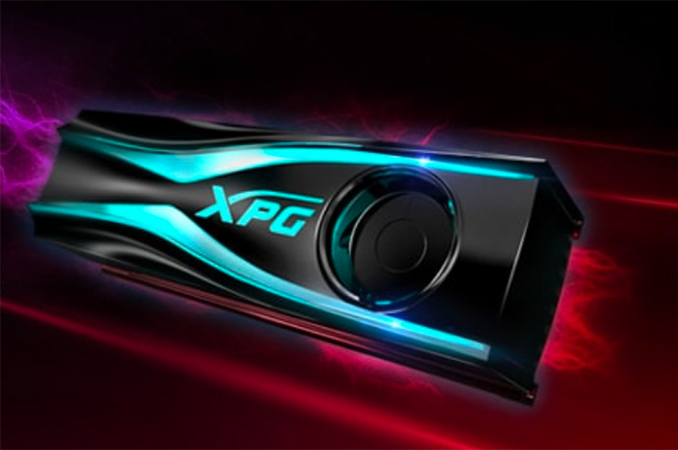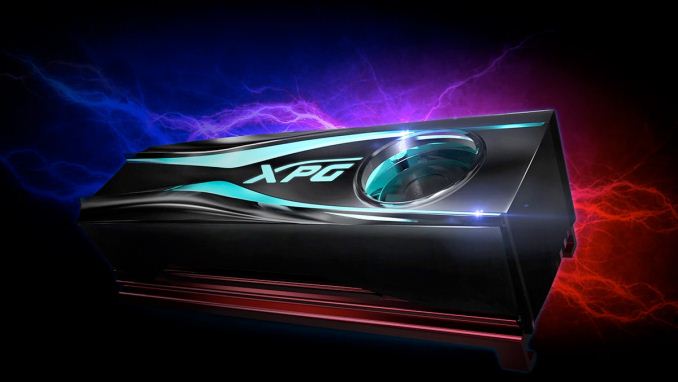ADATA Announces XPG Storm: A Cooler for M.2 SSDs with a 16500 RPM Fan
by Anton Shilov on November 22, 2017 2:00 PM EST- Posted in
- SSDs
- Cases/Cooling/PSUs
- ADATA
- M.2

ADATA this week has introduced its first aftermarket cooler for M.2-2280 SSDs. The XPG Storm is meant to ensure stable performance with the latest drives under high loads, while also adding some visual effects via its integrated RGB LEDs.
The ADATA XPG Storm features a large, ten fin anodized aluminum heatsink painted to resemble copper. The heatsink in turn is cooled by an Sunon MF20100V1-10000-A99 20-mm fan, a small-but-powerful fan that can spin at up to 16,500 RPM (see detailed specs of the unit below). Overall the cooler is 2.4 centimeters thick and is among the largest cooling devices for M.2 SSDs launched to date.
While dimensions of the XPG Storm will affect its compatibility with small form-factor PCs (e.g., Mini-ITX motherboards with an M.2 slot on the backside), the maximized surface area means better heat dissipation, further reducing any remaining thermal throttling under high loads. ADATA does not quantify advantages of its XPG Storm (it only says it makes SSDs 25% cooler, but that is not a very precise valuation), but according to EKWB, a passive heatsink can reduce controller temperature by 8-10°C, or even more with appropriate airflow. Since the XPG Storm has its own fan, expect it to perform a bit better than passive coolers. Meanwhile, keep in mind that the noise generated by the aforementioned 16,500 RPM fan is speced at 25 dBa, which is noticeable.
Besides just cooling SSDs, the ADATA XPG Storm is an accessory that adds style to a modern gaming PC. The shroud of the XPG Storm’s cooler features RGB LEDs that support external 4-pin RGB controllers, as well as ASUS Aura Sync, GIGABYTE RGB Fusion, and MSI Mystic Light Sync applications. The fan can be connected to a system fan header on a motherboard, or directly to a PSU using a an appropriate adapter.
The vast majority of high-performance SSDs these days use M.2 form-factor because of PCIe interface and broad compatibility with all types of desktop, laptop and even hybrid computers. However, M.2 drives have a drawback that affects their performance occasionally: they are hard to cool down. Modern SSD controllers contain multiple computing cores to perform rather intensive mathematical operations while using ECC based on LDPC algorithms in order to work with contemporary NAND flash memory, all the while the NAND dies themselves also produce heat of their own. As a result, high-end drives in particular have been known to throttle some in heavy write scenarios, especially in systems with poor airflow.
Manufacturers of SSDs naturally try to tackle heat issues by equipping their drives with thermal pads (Samsung) or heatsinks (ADATA, Plextor), but since the majority of M.2 SSDs come without any cooling, the market of custom cooling solutions for such drives is expanding. Over the past 12 months we have seen aluminium M.2 coolers from Alphacool (passive and liquid cooled) and EKWB (passive), whereas Silverstone is selling aftermarket thermal pads. As it appears, ADATA decided to take aftermarket cooling of its M.2 SSDs into its own hands, thus offering a comprehensive service to its demanding clients as well as increasing its revenue and profits.
| ADATA XPG Storm at a Glance | |||
| AnandTech.com | ASTORM-C | ||
| Bearing Type | Vapo-Bearing | ||
| Fan Diameter | 20 mm (?) | ||
| RPM | 16,500 RPM ± 15%, non-PWM | ||
| Airflow | 1.9 CFM (at 16,500 RPM) | ||
| Noise level | 25 dBA (max) | ||
| Fan life | unknown | ||
| RGB Compatibility | External controllers ASUS Aura Sync GIGABYTE RGB Fusion MSI Mystic Light Sync |
||
| Dimensions | 81.5 × 24.55 × 23.1 mm | ||
| Voltage | 12 V, 80 mA | ||
| MSRP | $29.99 | ||
| Check Availability | Amazon Newegg |
||
ADATA will start selling its XPG Storm cooler for $29.99 starting early next month. The unit will be covered by a one-year warranty.
Related Reading:













28 Comments
View All Comments
techguymaxc - Wednesday, November 22, 2017 - link
25dB is half the noise of a library. https://www.fceia.unr.edu.ar/acustica/comite/sound...Facts > uninformed internet hysteria.
surt - Wednesday, November 22, 2017 - link
On the plus side, 16khz is a nice high-end of human hearing squeal. Nobody minds high pitched squeals!stephenbrooks - Wednesday, November 22, 2017 - link
It's 16k RPM not RPS. That puts it at 16500/60 = 275Hz and a few harmonics of that. Bang in the middle of our sensitivity range!basroil - Wednesday, November 22, 2017 - link
25dB is massive considering noctua 120mm high flow fans are rated for <20dB (half the noise level of that) and deliver 50x more flow (so much, much cooler)ZeDestructor - Thursday, November 23, 2017 - link
36x the flow area, with significantly less of that flow area taken by the motor, and an axial fan compared to this radial fan (axial fans typically get much higher airflow than radial fans). Easy to get 50x the flow for half the noise if you think about it for more than -3s.basroil - Thursday, November 23, 2017 - link
Of course it is. And usually you ALREADY HAVE ONE OF THESE FANS PROVIDING COOLING. If your case has an intake and output fan combo, you likely are getting more CFM over the device as it is without additional forced convection. Don't spout nonsense about "flow restriction since the m.2 is under a gpu", since if it was then this cooler won't fit either!StrangerGuy - Wednesday, November 22, 2017 - link
Oh, so the dustbusters in 1U rack servers me and others deal with everyday aren't facts but just uninformed internet hysteria?nagi603 - Thursday, November 23, 2017 - link
When a manufacturer says 25dB, they are usually bullshitting. I've had 19dB fans that were quite a bit louder than a library.TheWereCat - Thursday, November 23, 2017 - link
They can say it's 0dB because they tested the noise from 1000km far awayMrSpadge - Thursday, November 23, 2017 - link
I've had fans where the manufacturer claimed 19 dB and they were not silent and definitely not library sound. Any dB rating depends highly on the distance to the sound source, so there's quite some leeway. Sure, the noise of that fan doesn't sound terrible, but it's still going to be unnecessary most of the time for SSDs with proper idle modes.